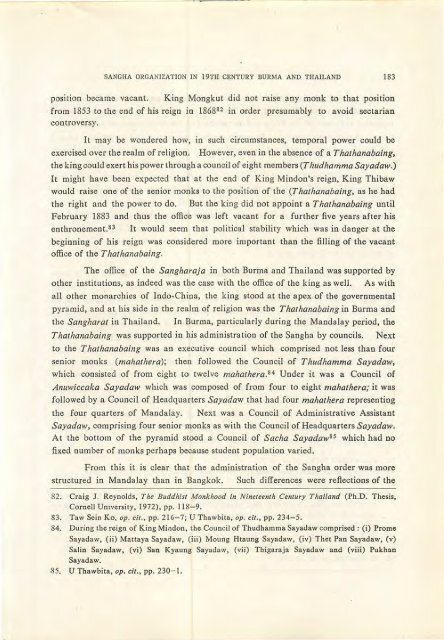The Journal of the Siam Society Vol. LXXII, Part 1-2, 1984 - Khamkoo
The Journal of the Siam Society Vol. LXXII, Part 1-2, 1984 - Khamkoo
The Journal of the Siam Society Vol. LXXII, Part 1-2, 1984 - Khamkoo
You also want an ePaper? Increase the reach of your titles
YUMPU automatically turns print PDFs into web optimized ePapers that Google loves.
SANGHA ORGANIZATION IN 19TH CENTURY BURMA AND THAILAND 183<br />
position became vacant. King Mongkut did not raise any monk to that position<br />
from 1853 to <strong>the</strong> end <strong>of</strong> his reign in 1868 82 in order presumably to avoid sectarian<br />
controversy.<br />
It may be wondered how, in such circumstances, temporal power could be<br />
exercised over <strong>the</strong> realm <strong>of</strong> religion. However, even in <strong>the</strong> absence <strong>of</strong> a Thathanabaing,<br />
<strong>the</strong> king could exert his power through a council <strong>of</strong> eight members (Thud hamma Sayadaw.)<br />
It might have been expected that at <strong>the</strong> end <strong>of</strong> King Mindon's reign, King Thibaw<br />
would raise one <strong>of</strong> <strong>the</strong> senior monks to <strong>the</strong> position <strong>of</strong> <strong>the</strong> (Thathanabaing, as he had<br />
<strong>the</strong> right and <strong>the</strong> power to do. But <strong>the</strong> king did not appoint a Thathanabaing until<br />
February 1883 and thus <strong>the</strong> <strong>of</strong>fice was left vacant for a fur<strong>the</strong>r five years after his<br />
enthronement.s3 It would seem that political stability which was in danger at <strong>the</strong><br />
beginning <strong>of</strong> his reign was considered more important than <strong>the</strong> filling <strong>of</strong> <strong>the</strong> vacant<br />
<strong>of</strong>fice <strong>of</strong> <strong>the</strong> Thathanabaing.<br />
<strong>The</strong> <strong>of</strong>fice <strong>of</strong> <strong>the</strong> Sangharaja m both Burma and Thailand was supported by<br />
o<strong>the</strong>r institutions, as indeed was <strong>the</strong> case with <strong>the</strong> <strong>of</strong>fice <strong>of</strong> <strong>the</strong> king as well. As with<br />
all o<strong>the</strong>r monarchies <strong>of</strong> Indo-China, <strong>the</strong> king stood at <strong>the</strong> apex <strong>of</strong> <strong>the</strong> governmental<br />
pyramid, and at his side in <strong>the</strong> realm <strong>of</strong> religion was <strong>the</strong> Thathanabaing in Burma and<br />
<strong>the</strong> Sangharat in Thailand. In Burma, particularly during <strong>the</strong> Mandalay period, <strong>the</strong><br />
Thathanabaing was supported in his administration <strong>of</strong> <strong>the</strong> Sangha by councils.<br />
Next<br />
to <strong>the</strong> Thathanabaing was an executive council which comprised not less than four<br />
senwr monks (maha<strong>the</strong>ra); <strong>the</strong>n followed <strong>the</strong> Council <strong>of</strong> Thudhamma Sayadaw,<br />
which consisted <strong>of</strong> from eight to twelve maha<strong>the</strong>ra.84 Under it was a Council <strong>of</strong><br />
Anuwiccaka Sayadaw which was composed <strong>of</strong> from four to eight maha<strong>the</strong>ra; it was<br />
followed by a Council <strong>of</strong> Headquarters Sayadaw that had four maha<strong>the</strong>ra representing<br />
<strong>the</strong> four quarters <strong>of</strong> Mandalay. Next was a Council <strong>of</strong> Administrative Assistant<br />
Sayadaw, comprising four senior monks as with <strong>the</strong> Council <strong>of</strong> Headquarters Sayadaw.<br />
At <strong>the</strong> bottom <strong>of</strong> <strong>the</strong> pyramid stood a Council <strong>of</strong> Sacha Sayadawss which had no<br />
fixed number <strong>of</strong> monks perhaps because student population varied.<br />
From this it is clear that <strong>the</strong> administration <strong>of</strong> <strong>the</strong> Sangha order was more<br />
structured in Mandalay than in Bangkok . Such differences were reflections <strong>of</strong> <strong>the</strong><br />
. 82. Craig J. Reynolds, <strong>The</strong> Buddhist Monkhood in Nineteenth Century Thailand (Ph.D. <strong>The</strong>sis,<br />
Cornell University, 1972), pp. 118-9.<br />
83. Taw Sein Ko, op. cit., pp. 216-7; U Thawbita, op. cit., pp. 234-5.<br />
'84. During <strong>the</strong> reign <strong>of</strong> King Mindon, <strong>the</strong> Council <strong>of</strong> Thudhamma Sayadaw comprised: (i) Prome<br />
Sayadaw, (ii) Mattaya Sayadaw, (iii) Moung Htaung Sayadaw, (iv) <strong>The</strong>t Pan Sayadaw, (v)<br />
Salin Sayadaw, (vi) San Kyaung Sayadaw, (vii) Thigaraja Sayadaw and (viii) Pukhan<br />
Sayadaw .<br />
.85. U Thawbita, op. cit., pp. 230-1.

















